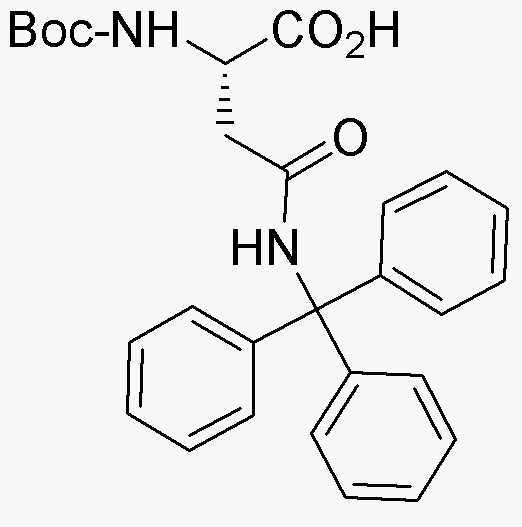Na-Boc-Ng-trityl-L-asparagine is widely utilized in research focused on:
- Peptide Synthesis: This compound serves as a protecting group in the synthesis of peptides, allowing chemists to selectively modify amino acids without affecting others, thus streamlining the production of complex peptides.
- Drug Development: It plays a crucial role in the development of pharmaceutical compounds, particularly in the design of novel therapeutics that target specific biological pathways, enhancing drug efficacy.
- Bioconjugation: Researchers use it for bioconjugation processes, where it helps attach biomolecules to drugs or imaging agents, improving the specificity and effectiveness of treatments.
- Protein Engineering: The compound is essential in protein engineering, allowing scientists to create modified proteins with enhanced stability and activity for various applications, including enzyme design.
- Research in Neuroscience: It is utilized in studies related to neurotransmitter signaling, aiding in the understanding of neurological pathways and potential treatments for neurodegenerative diseases.
General Information
Properties
Safety and Regulations
Applications
Na-Boc-Ng-trityl-L-asparagine is widely utilized in research focused on:
- Peptide Synthesis: This compound serves as a protecting group in the synthesis of peptides, allowing chemists to selectively modify amino acids without affecting others, thus streamlining the production of complex peptides.
- Drug Development: It plays a crucial role in the development of pharmaceutical compounds, particularly in the design of novel therapeutics that target specific biological pathways, enhancing drug efficacy.
- Bioconjugation: Researchers use it for bioconjugation processes, where it helps attach biomolecules to drugs or imaging agents, improving the specificity and effectiveness of treatments.
- Protein Engineering: The compound is essential in protein engineering, allowing scientists to create modified proteins with enhanced stability and activity for various applications, including enzyme design.
- Research in Neuroscience: It is utilized in studies related to neurotransmitter signaling, aiding in the understanding of neurological pathways and potential treatments for neurodegenerative diseases.
Documents
Safety Data Sheets (SDS)
The SDS provides comprehensive safety information on handling, storage, and disposal of the product.
Product Specification (PS)
The PS provides a comprehensive breakdown of the product’s properties, including chemical composition, physical state, purity, and storage requirements. It also details acceptable quality ranges and the product's intended applications.
Certificates of Analysis (COA)
Search for Certificates of Analysis (COA) by entering the products Lot Number. Lot and Batch Numbers can be found on a product’s label following the words ‘Lot’ or ‘Batch’.
Numéro de catalogue
Numéro de lot/série
Certificates Of Origin (COO)
This COO confirms the country where the product was manufactured, and also details the materials and components used in it and whether it is derived from natural, synthetic, or other specific sources. This certificate may be required for customs, trade, and regulatory compliance.
Numéro de catalogue
Numéro de lot/série
Safety Data Sheets (SDS)
The SDS provides comprehensive safety information on handling, storage, and disposal of the product.
DownloadProduct Specification (PS)
The PS provides a comprehensive breakdown of the product’s properties, including chemical composition, physical state, purity, and storage requirements. It also details acceptable quality ranges and the product's intended applications.
DownloadCertificates of Analysis (COA)
Search for Certificates of Analysis (COA) by entering the products Lot Number. Lot and Batch Numbers can be found on a product’s label following the words ‘Lot’ or ‘Batch’.
Numéro de catalogue
Numéro de lot/série
Certificates Of Origin (COO)
This COO confirms the country where the product was manufactured, and also details the materials and components used in it and whether it is derived from natural, synthetic, or other specific sources. This certificate may be required for customs, trade, and regulatory compliance.


